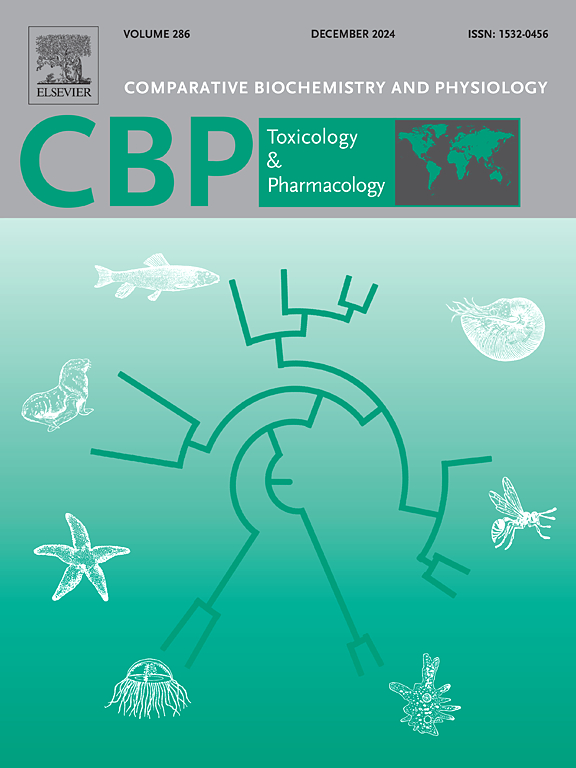Enhanced uptake of perfluorooctanoic acid by polystyrene nanoparticles in Pacific oyster (Magallana gigas)
IF 3.9
3区 环境科学与生态学
Q2 BIOCHEMISTRY & MOLECULAR BIOLOGY
Comparative Biochemistry and Physiology C-toxicology & Pharmacology
Pub Date : 2024-12-24
DOI:10.1016/j.cbpc.2024.110119
引用次数: 0
Abstract
The effects of plastic pollution on marine organisms is of growing concern. The hydrophobic surface of plastics adsorbs organic contaminants and can alter the rate of chemical uptake in fishes. Per-fluorinated organic chemicals such as Perfluorooctanoic acid (PFOA) are highly hydrophobic toxic chemicals that adsorb to hydrophobic surfaces. We hypothesized that the presence of nano-sized plastic particles adsorbs PFOA and alter both the physical-chemical properties of the plastics and also enhance PFOA uptake into organisms. Using radiolabelled 14C-PFOA, we measured direct unidirectional uptake of PFOA in juvenile Pacific Oysters (Magallana gigas) at different (0.025, 0.50, and 0.100 mg/L) concentrations, for different exposure periods (1, 2, 4, and 6 h) and investigated whether varying concentrations (0.1, 0.5, 1 mg/L) of either 500 nm or 20 nm polystyrene nanoparticles (PS-NPs) differentially altered the uptake rate of PFOA. Our results demonstrate that PFOA adsorbs to the surface of PS-NPs, altering PS-NP behaviour in solution and significantly increases the rate of uptake of PFOA in exposed Pacific oysters. PFOA uptake at 0.1 mg/L was increased 2.3-fold in the presence of 1 mg/L 500 nm PS-NP and 3.2-fold in the presence of 1 mg/L 20 nm PS-NP. In a separate study to examine if PS NPs potentiate the biochemical response to PFOA, both 500 and 20 nm PS-NP at 100 mg/L increased the 1 mg/L PFOA-induced oxidative stress by 2.5-fold and 3-fold respectively. These findings demonstrate that nanoplastics as co-contaminants in marine systems are able to adsorb PFOA and significantly potentiate its uptake and toxicity.

聚苯乙烯纳米颗粒增强太平洋牡蛎(Magallana gigas)对全氟辛酸的吸收
塑料污染对海洋生物的影响日益受到关注。塑料的疏水表面能吸附有机污染物,并能改变鱼类对化学物质的吸收速度。全氟有机化学品,如全氟辛酸(PFOA)是高度疏水的有毒化学品,可吸附在疏水表面。我们假设纳米塑料颗粒的存在可以吸附PFOA,改变塑料的物理化学性质,也可以增强PFOA被生物体吸收。使用放射性标记的14C-PFOA,我们测量了不同浓度(0.025、0.50和0.100 mg/L)、不同暴露时间(1、2、4和6 h)下太平洋牡蛎(Magallana gigas)幼牡蛎(Magallana gigas)对PFOA的直接单向摄取,并研究了500 nm或20 nm聚苯乙烯纳米颗粒(PS-NPs)的不同浓度(0.1、0.5、1 mg/L)是否会改变PFOA的摄取速率。我们的研究结果表明,PFOA吸附在PS-NP表面,改变了PS-NP在溶液中的行为,并显著增加了暴露在太平洋牡蛎中PFOA的吸收率。500 nm PS-NP浓度为1 mg/L时,PFOA吸收量增加2.3倍,20 nm PS-NP浓度为1 mg/L时,PFOA吸收量增加3.2倍。在另一项关于PS- np是否增强PFOA生化反应的研究中,500和20 nm的100 mg/L PS- np分别使1 mg/L PFOA诱导的氧化应激分别增加2.5倍和3倍。这些发现表明,纳米塑料作为海洋系统中的共污染物能够吸附PFOA,并显著增强其吸收和毒性。
本文章由计算机程序翻译,如有差异,请以英文原文为准。
求助全文
约1分钟内获得全文
求助全文
来源期刊
CiteScore
7.50
自引率
5.10%
发文量
206
审稿时长
30 days
期刊介绍:
Part C: Toxicology and Pharmacology. This journal is concerned with chemical and drug action at different levels of organization, biotransformation of xenobiotics, mechanisms of toxicity, including reactive oxygen species and carcinogenesis, endocrine disruptors, natural products chemistry, and signal transduction with a molecular approach to these fields.

 求助内容:
求助内容: 应助结果提醒方式:
应助结果提醒方式:


